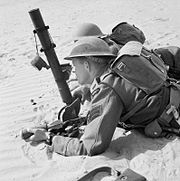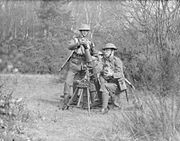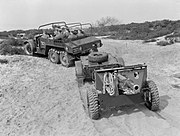
I Corps was an army corps in existence as an active formation in the British Army for most of the 80 years from its creation in the First World War until the end of the Cold War, longer than any other corps. It had a short-lived precursor during the Waterloo Campaign. It served as the operational component of the British Army of the Rhine during the Cold War, and was tasked with defending West Germany.
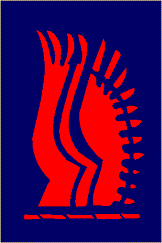
The 24th Infantry Brigade was an infantry brigade of the British Army from the First World War. It was reraised during the Second World War, as the 24th Infantry Brigade (Guards). During various designations, the brigade was active throughout the Cold War and existed until 1999, when it was merged with the 5 Airborne Brigade to become 16 Air Assault Brigade.
The Malaya Command was a formation of the British Army formed in the 1920s for the coordination of the defences of British Malaya, which comprised the Straits Settlements, the Federated Malay States and the Unfederated Malay States. It consisted mainly of small garrison forces in Kuala Lumpur, Penang, Taiping, Seremban and Singapore.
In September 1939, the British Army was in process of expanding their anti-aircraft and mobile assets. Among these new changes was the formation of Anti-Aircraft Command which was formed on 1 April 1939, and the 1st Armoured Division formed in 1937. The list below will include the British Army units, colonial units, and those units which were in the process of formation.
1st Anti-Aircraft Brigade was an Air Defence formation of the British Army, during the Second World War, and served in the Battle of France and during The Blitz. It then transferred to the Middle East, where it defended the Eighth Army's lines of communication during the final phases of the North African Campaign.
The 224th Brigade was a Home Defence formation of the British Army in World War I and World War II. It existed under several variations of the 224th Brigade title.

The 1st Anti-Aircraft Division was an Air Defence formation of the British Army before and during the early years of the Second World War. It defended London during the Battle of Britain and The Blitz.
27th Anti-Aircraft Brigade was an Air Defence formation of the British Army in the Second World War that served in The Blitz and later converted to infantry.
The Tynemouth Volunteer Artillery claims to be the oldest volunteer artillery unit of the British Army. It served coastal and siege guns in World War I and World War II, and also served in the infantry role.
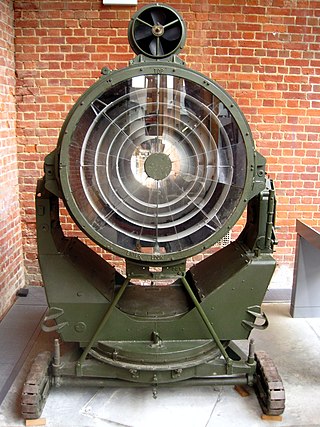
The 36th (Middlesex) Searchlight Regiment was a volunteer air defence battalion of Britain's Territorial Army (TA) from 1936 until 1961, at first as part of the Royal Engineers, later in the Royal Artillery. As part of 40th Anti-Aircraft Brigade it defended air bases in East Anglia through the Battle of Britain and the Blitz. Towards the end of 1944 the unit underwent infantry training, serving briefly in Norway at the end of the war. After the war, the 36th continued as a TA unit, with some women serving with it. In 1961, the remnants of the regiment amalgamated with others to form a combined infantry battalion, and all links with air defence were severed.
The 30th (Northumbrian) Anti-Aircraft Brigade was an air defence formation of Britain's Territorial Army from 1936 until 1955, which defended Tyneside and Sunderland during the Second World War.

The 2nd Anti-Aircraft Division was an Air Defence formation of the British Army from 1935 to 1942. It controlled anti-aircraft gun and searchlight units of the Territorial Army (TA) defending the East Midlands and East Anglia during The Blitz.
58th (Middlesex) Searchlight Regiment, Royal Artillery was an air defence unit of Britain's Territorial Army (TA) raised just before World War II. It defended the East Midlands of England during The Blitz, and later served as infantry in North West Europe at the end of the war, converting to the anti-aircraft (AA) artillery role postwar.
The Essex (Fortress) Royal Engineers was a volunteer unit of Britain's Royal Engineers formed to defend the Essex coast. It served in this role in World War I and then converted to a searchlight regiment for air defence in World War II. The unit ended the war as a garrison infantry battalion. Its descendants continued to serve in the Territorial Army until 1955.

The page contains the current structure of the British Army. The British Army is currently being reorganised to the Future Soldier structure.
The Order of battle, Keren 1941 shows Italian army forces that participated in the Battle of Keren from February to March 1941 and British troops in Sudan on 20 January 1941, which participated in military operations against Eritrea during the East African Campaign 1940–1941.

The 1st Devonshire Artillery Volunteers and its successor units served in the British Army's Reserve Forces from 1859 to 1961. During World War I it carried out garrison duty in British India but went on to see active service in the Third Anglo-Afghan War. Converting to an air defence role before World War II its units participated in the Norwegian campaign and the Dunkirk evacuation, the Battle of Britain and then the campaigns in North Africa, Italy, and Burma
The 1st Searchlight Regiment, Royal Artillery was an air defence unit of the British Army from 1920 until 1954. Originally formed in the Royal Engineers (RE), it was transferred to the Royal Artillery (RA) at the start of World War II. It fought with distinction in the defence of Calais during the Battle of France, in which it was virtually destroyed. Reformed, it helped to protect the cities of South Wales from the Luftwaffe during The Blitz, and later defended the South Coast of England against Fighter bomber and V-1 flying bomb attacks. It went to North West Europe to defend Antwerp during the final stages of the war, and served in the Gibraltar garrison postwar.

The Royal Malta Artillery (RMA) was a regular artillery unit of the British Army prior to Malta's independence. It was formed in 1889, having been called the Royal Malta Fencible Artillery from 1861 until 1889.
















